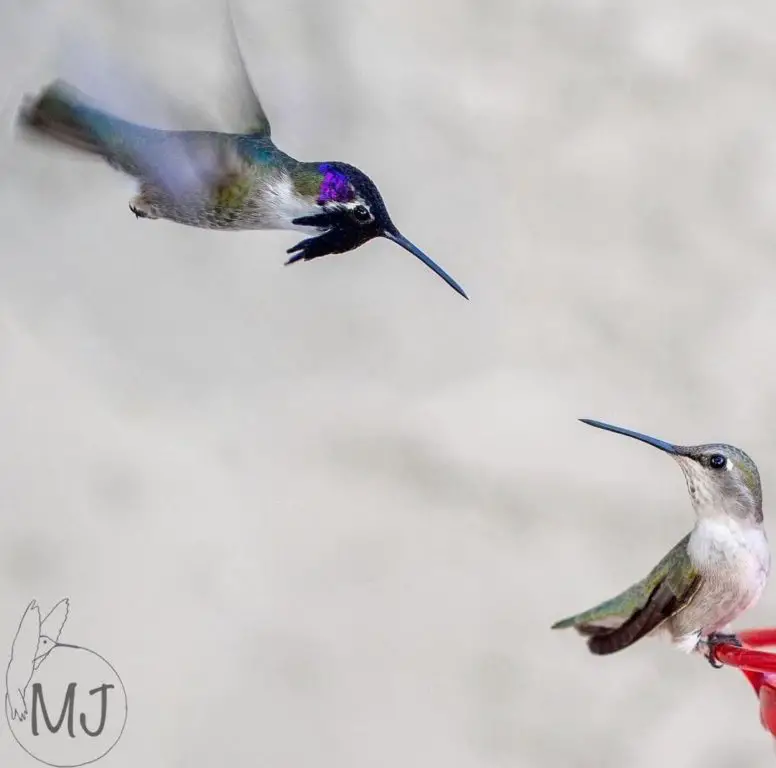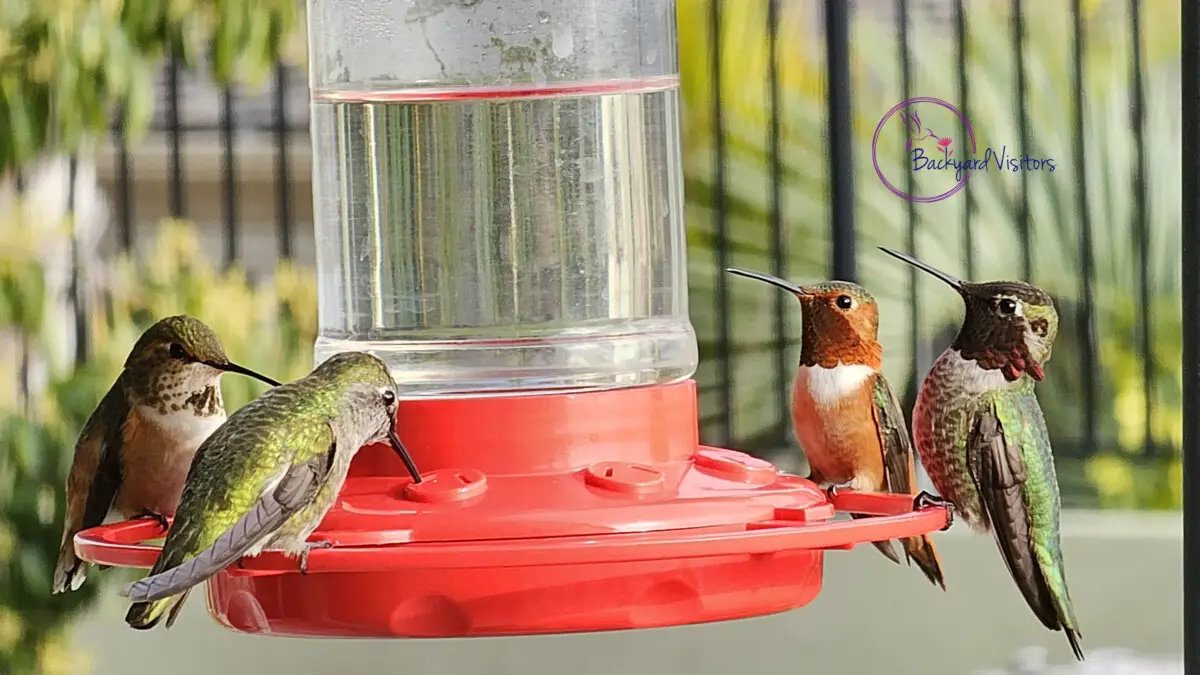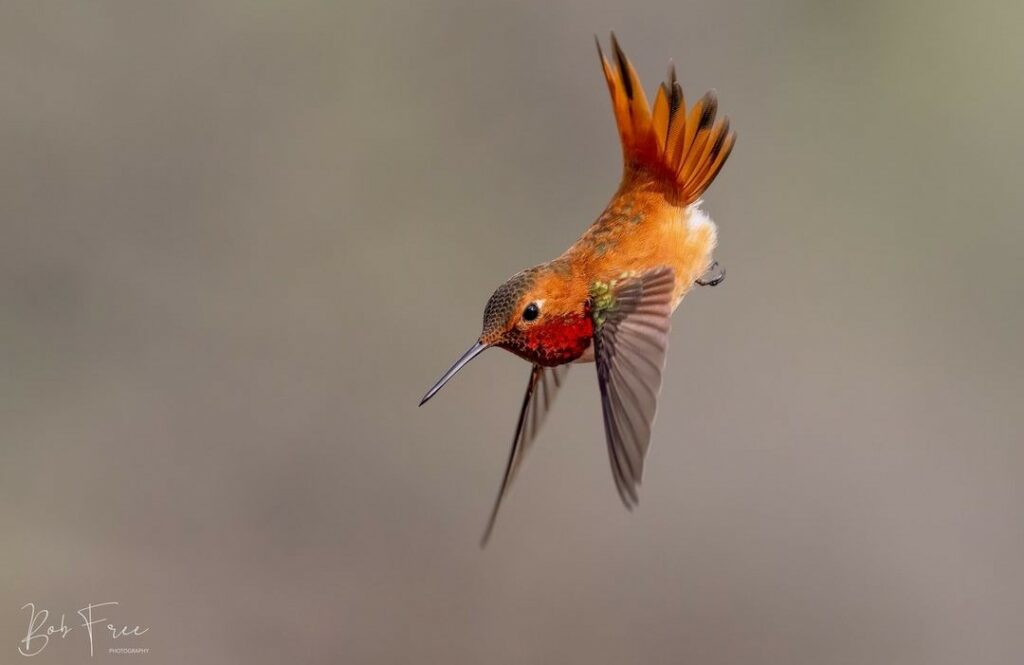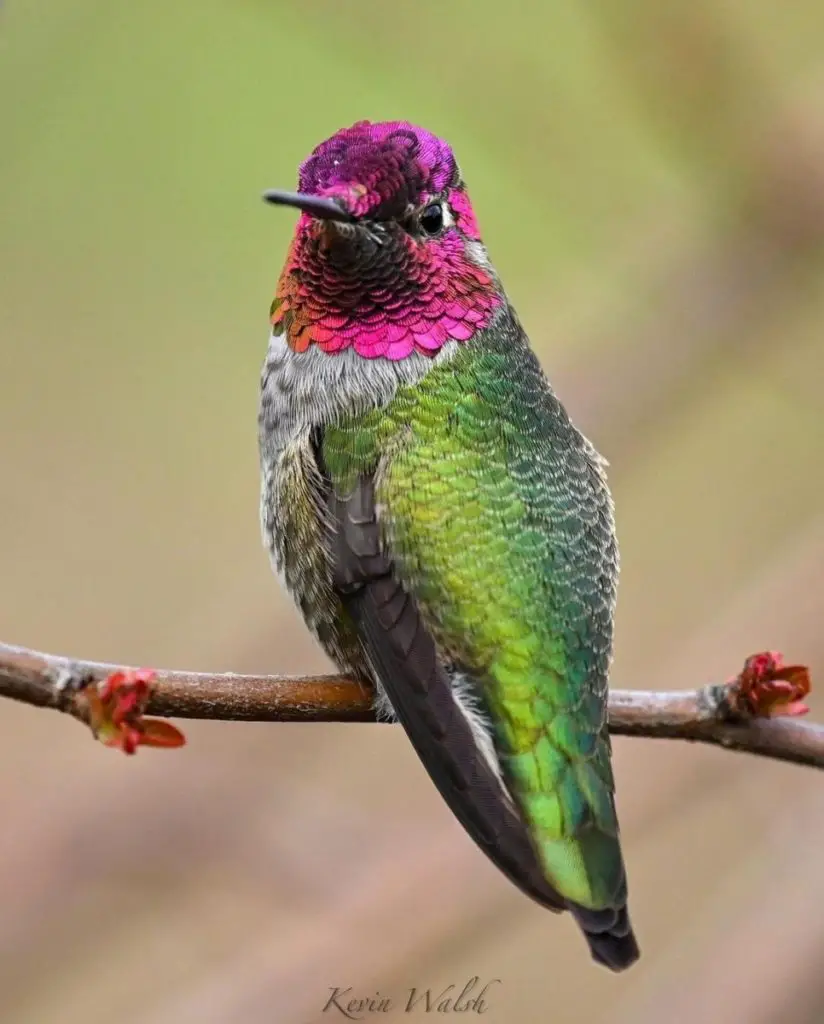This post contains affiliate links.
Learn effective strategies to manage bully hummingbirds and protect your hummingbird feeders. This guide offers tips to deter aggressive behavior and maintain a peaceful haven for all your feathered friends.
Hummingbirds are dazzling jewels of the avian world, bringing a touch of dynamism to any garden. However, their enchanting presence is sometimes overshadowed by their aggressive behaviors, leading to the all-too-common problem of hummingbird bullies at the feeders.
In this insightful exploration, we will delve into strategies and practical advice for managing these feisty fliers.
From understanding the social dynamics of hummingbirds to implementing effective deterrent methods, we aim to restore peace and ensure that all hummingbirds coexist and enjoy the bounty of the feeders.
Understanding Hummingbird Behavior: Insights on Feeder Bully Tactics
Observing the fluttering beauty of hummingbirds at a backyard feeder is a captivating experience for any bird enthusiast. Within these delicate avians exists a fierce competitive streak, particularly prevalent among male hummingbirds, which leads to what is referred to as feeder bully behavior.
Understanding hummingbird behavior, especially concerning feeder contests, requires recognizing the root of aggression in these seemingly gentle creatures.
Bully hummingbirds are commonly the males displaying territorial aggression to assert dominance over a preferred nectar source.
Vigorous hummingbird fights at feeders are frequent with the bully bird engaging in tactics such as chasing, body slamming, and the use of their pointed beak as a sword.

Photo by: hummingbirdsbysuprise
Despite the pervasive image of serenity associated with these charming birds, hummingbird aggression is a natural response to their survival needs. These hummingbird feeder squabbles are not merely for show.
Behind this aggression lies an evolutionary imperative to control the best feeding spots which in turn ensures a higher survival and mating success rate.
Whether it is a male performing dive displays or relentless chases, it is essential to remember that each hummingbird is vying for the necessary sustenance provided by the nectar within your hummingbird feeders.
As a hummingbird enthusiast, I have noted that multiple feeders placed close together will exacerbate situations of heightened aggression giving the bully bird easier means to monopolize the resource.
When creating a hummingbird oasis in your garden, consider the innate behavior of these iridescent wonders.
Implementing tactics such as spacing the multiple feeders, encouraging diversity in feed times and making subtle adjustments to the placement of each hummingbird feeder will ensure that bully hummingbirds do not monopolize a feeder and is a strategic approach to mitigate intense aerial dogfights.
Balanced distribution of feeders reduces the likelihood of a single bully hummingbird gatekeeping the food source.
An in-depth understanding of hummingbird behavior at feeders involves identifying less obvious forms of intimidation. A bully bird may not always engage directly in combat. It might instead use strategic perching to surveil and guard the hummingbird feeder territory, launching at intruders with great speed when its vigilant watch detects a breach.
Solutions for deterring this type of bully behavior include camouflaging the feeder or altering feeding times, making it less predictable for the bully hummingbird to capitalize on the feeding schedule.
Strategies to Minimize Hummingbird Fights at Your Feeders
To minimize hummingbird fights at your feeders, implement several strategies to create a more peaceful environment for these extremely territorial birds.
Aerial skirmishes are primarily due to the inherent territorial behavior of the hummingbird species. When a bully hummingbird takes control of a hummingbird feeder, it leads to undue stress for other birds and a decrease in the diversity of visitors to your garden.
Hummingbirds are naturally competitive, especially during feeding times, but thoughtful placement and management of feeders, will reduce the frequency of these disputes.
Strategic placement of feeders spread throughout your yard and out of sight of each other will discourage any single bird from claiming all the feeders as its territory. By placing feeders at different heights and in different types of locations (ie: near bushes, open spaces, and shaded areas), appeals to the various birds’ preferences and reduces competition.
This prevents a dominant hummingbird the ability to guard all the feeders at once, and allows more birds to feed without conflict.
When hummingbirds can not view another feeder, they are less likely to exhibit territorial behavior and more likely to share the wealth with their feathered counterparts.
Feeders with numerous ports encourage multiple hummingbirds to feed simultaneously, reducing the likelihood of confrontations.

When hummingbirds are in flight and hovering at a feeder they have a heightened sense of their surroundings and are inclined to defend and protect their food supply from an intruder and are less likely to share.
On the other hand, when a hummingbird is perched on a feeder the solitary focus is on feeding and is more relaxed and likely to share.
Regularly keeping feeders clean and free from mold and bacteria is crucial. A clean feeder will attract more birds. By maintaining a healthy environment, the hummingbird population in your yard will be robust and less competitive for resources.
The presence of natural food sources such as flowers draws hummingbirds away from feeders and reduces bullying. Augment your feeders with natural food sources. By establishing a habitat rich in nectar-producing flora, you ensure that hummingbirds have ample feeding options.
Planting a hummingbird-friendly garden with flowers that naturally attract these birds provide alternative feeding sources and reduce dependency on feeders. Flowers such as bee balm, salvia, and zinnias are excellent choices.
This lessens the pressure on feeders and in turn, reduces bully behavior.
Monitor the behavior of the hummingbirds visiting your feeders. If you notice consistent conflicts, adjust the locations of the feeders or the types of feeders you are using.
To specifically target and deter the overly assertive feeder bullies, I recommend temporarily removing the feeder when bullying behavior peaks. This disrupts the bully’s dominance pattern, allowing other hummingbirds to establish a presence.
Remove the feeder all together until the bully realizes their protected nectar source has disappeared. Once they settle down or move to a new location, re-introduce the feeder to your backyard.
Once removing a feeder from a bully hummingbird’s territory, I have seen the bully stand guard and protect an empty space before realizing that no one is coming or that the feeder has been moved.
While it may seem counterintuitive, short-term feeder removal has long-term benefits in establishing a more peaceful feeding environment.
Observation is key to understanding the specific dynamics of your local hummingbird population. Implementing these strategies significantly reduces the frequency of hummingbird fights at your feeders, making your yard a peaceful and welcoming environment for these fascinating birds.
Confronting Aggression: How Hummingbirds Chase and Claim Territory
Confronting aggression in hummingbirds, as they chase and claim territory, is a dramatic display of nature’s intensity even among the smallest creatures. These diminutive birds, often associated with grace and beauty are also some of the most fiercely territorial animals.
Certain individuals assert dominance through aggressive behavior, becoming what is colloquially termed as a bully bird.
Male bullying hummingbirds with their resplendent throats aglow, are known to fiercely guard resources, especially prized hummingbird feeders, from perceived competitors.
Their aggressive behavior is primarily driven by the need to secure and defend food sources, such as nectar-rich flowers and hummingbird feeders that are crucial for their high-energy lifestyle.
See my article: Why Hummingbirds Chase Each Other: Is it Friend or Foe?

Photo by: Anthony Lujan
The size of the territory varies depending on the abundance of resources and the density of the hummingbird population in the area.
When a hummingbird spots a potential threat to its territory, it will use its speed and agility to chase away the intruder, engaging in high-speed chases that are a testament to its flying skills.
There are four chasing tactics that are performed by hummingbirds to confidently claim their territory:
- Dive displays
- Chasing
- Physical confrontations
- Hovering displays
Hummingbirds claim territory by establishing a presence through frequent patrols and vocalizations. They often perch in a high, visible location within the territory to survey their domain and watch for intruders.
One of the most common and dramatic tactics of aggression used by hummingbirds in territorial defense is dive bombing. A hummingbird will climb up to 100 feet in the air before swooping down at high speeds towards the intruder, pulling up at the last moment.
This maneuver serves as a warning and is often accompanied by a distinct and loud buzzing or chirping sound created by the bird’s wings, followed by chittering vocalizations, adding to the intimidation factor.
The dive bomb is a clear message to back off. While it rarely results in physical contact, it is an effective strategy in asserting dominance.
Hummingbirds engage in direct chases, rapidly pursuing intruders through trees, around bushes, and even in open spaces to drive them away from their territory. These high-speed pursuits showcase the hummingbird’s agility and determination to defend its area.
While hummingbirds prefer to avoid physical confrontations due to the risk of injury, they will engage if necessary, by pecking, clawing in mid-air, and using their beaks as weapons.
Such encounters are energy-intensive and risky, therefore hummingbirds resort to them only when other tactics have failed to deter the intruder. These skirmishes are generally brief but intense.
A hummingbird may hover directly in front of another bird, flapping its wings vigorously to display its strength and agility, effectively communicating its dominance and territorial claim without resorting to physical contact.
The defending bird needs to balance the energy expended in chasing away intruders with the energy intake from feeding. Consequently, territories must contain enough resources to make this energy expenditure worthwhile.
For those interested in attracting hummingbirds without encouraging aggressive territorial disputes, strategies include spacing multiple feeders widely apart and out of sight of each other to prevent a single bird from dominating, providing natural floral food sources such as flowers to disperse feeding sites, and arranging the garden in a way that creates natural barriers and separate territories reduce conflicts and support the needs of these territorial birds.
Exploring the Territorial Behavior of Hummingbirds
The territorial behavior of hummingbirds is a fascinating aspect of their biology, showcasing their complex social interactions and survival strategies.
Among hummingbirds, aggression is often observed, particularly in males, who exhibit fierce territorial instincts over prime feeding locations.
Sporting striking male plumage acts as a visual cue of strength and vitality. These male hummingbirds display classical aggression, ensuring that their dominance is acknowledged.
Hummingbirds’ territorial behavior is primarily driven by the need to secure and defend reliable food sources. This behavior is crucial for their survival, given their high metabolism and the constant need for energy-rich nectar.
They expend a tremendous amount of energy in flight and as a result require frequent access to nectar. To ensure this availability, hummingbirds select and claim and defend territories based on the abundance of food resources.
A territory with an abundant density of flowering plants or feeders is highly desirable and becomes the center of intense competition. They aggressively chase away other birds that pose a threat to this resource.
Once a territory is claimed, the hummingbird employs defensive tactics of aerial displays, vocalizations and physical confrontation to ward off intruders.
Hummingbirds chase away intruders with a display of darting flights and acrobatics, indicative of their desire to dominate a preferred area. It is common to witness a bully hummingbird or a bully bird in general, commandeering a hummingbird feeder, zealously guarding it against any feathered contender.
The existence of a feeder bully is not a mere anecdote; many enthusiasts attest to the frequent sightings of one hummingbird that rules the roost. Such aggressive behavior is not solely for amusement.
It is rooted in the bird’s basic survival instincts, with the strongest males often taking up the mantle of protector and proprietor. This in turn attracts females ensuring mating success.
The relentless nature of a territorial hummingbird inadvertently results in a scarcity of opportune feeding moments for other birds, thus providing a means for requiring human intervention to uphold a harmonious avian assembly.
The territorial behavior of hummingbirds, while driven by the basic need for food, reveals the complexity of their social interactions and the sophisticated strategies they employ to survive.
This behavior not only affects the dynamics within hummingbird populations but also has broader ecological implications, influencing pollination patterns and plant diversity. By understanding and respecting these behaviors, humans can create environments that support the needs of hummingbirds, promoting biodiversity and the health of ecosystems.
Implementing Solutions to Discourage Bully Hummingbirds
To discourage bully hummingbirds from dominating feeders and to ensure a harmonious environment for all visiting hummingbirds, several strategies are implemented including the use of multiple feeders with perches, adjust feeder locations, use natural barriers and increase food sources.
These tactics aim to reduce aggressive territorial behavior and allow for more equitable access to food sources.
Spread out feeders: Place several feeders around your yard, making sure they are out of sight from each other. This prevents a dominant hummingbird from being able to monopolize all the feeders at once and reduces encounters between territorial birds.
Having multiple feeders in different areas of your garden reduces the chance of a single bully bird monitoring, guarding and controlling all the food resources.
Furthermore, placing some feeders out of sight from others blocks a bully’s ability to be territorial, as they cannot patrol what they cannot see.
Hummingbirds are on high alert of their surroundings while they are flying and hovering over a feeder. As a result, they are less likely to share and are focused to defend and safeguard their food supply from intruders.
On the other hand, if you opt for feeders with perches, a hummingbird’s solitary attention is on feeding when it is perched on a feeder, where it is more at ease and willing to share.
Change scenery: Periodically move feeders to different locations to disrupt a dominant bird’s ability to claim a single feeder as its own territory. This change forces the bully to adapt continuously, reducing aggressive behavior towards other birds, diverting its energy to finding the new location of the feeder and re-adjusting its strategies.
Strategic planting: Use plants, shrubs, or trees to create natural barriers in your garden. These obstruct the line of sight between feeders, increasing the challenge of a bully hummingbird to monitor multiple feeders at once.
Increase food sources: Plant nectar-rich flowers by augmenting your garden with plants that naturally attract hummingbirds and provide alternative food sources, reducing competition at feeders. Flowers such as bee balm, salvia, and zinnias attract hummingbirds, offering them a variety of feeding options.
Provide numerous feeder options that are available to all hummingbirds to reduce aggressive and bully hummingbirds. More feeders allow the opportunity for other hummingbirds to feed peacefully while the bully is preoccupied in their own world of defending their own feeder.
Temporarily removing the feeder when fights break out or when a bully bird is over-assertive disrupts that pattern of behavior. The absence of the feeder prompts the birds to seek alternative food sources, potentially reducing the bully’s attachment to that specific location.
When the feeder is reintroduced, the environmental dynamic has changed, creating room for more harmonious interactions.
Implementing these solutions helps create a more balanced and peaceful feeding environment for hummingbirds in your garden. These strategies aim to minimize the opportunities for a single bird to dominate the food sources, encouraging a more equitable and stress-free feeding situation for all visiting hummingbirds.
Hummingbird Species That Bully The Most
In the world of hummingbirds, territorial and aggressive behaviors vary across species, with some showing more dominant or “bully” tendencies than others, giving them the nickname of a bully hummingbird.
These behaviors are often observed around feeding sites, such as nectar feeders, where competition for resources leads to frequent conflicts.
Here are a few hummingbird species that are noted for their more aggressive, territorial behaviors: the Rufous, Anna’s and Ruby-throated hummingbirds.
The Rufous hummingbird (Selasphorus rufus) is often cited as the most aggressive hummingbird species towards both its own species and others.
Rufous hummingbirds are aggressive when defending food resources. They will chase away other hummingbirds from feeders and flowers, often engaging in aerial battles.
Despite its small size, the Rufous hummingbird’s exhibit a robust, bold and territorial behavior that belies its diminutive stature. Often engaging in hummingbird fights that seem disproportionately fierce for their size, they are a formidable defender of its feeding and nesting territories.

Photo by: Bob Free
Their aggression is not limited to other Rufous hummingbirds. They will confront and chase away much larger species, including birds several times their size.
This aggressive behavior is thought to be an evolutionary adaptation that allows these small birds to secure enough resources to survive and sustain their energy-intensive lifestyle including the breeding season and securing a mate for reproduction.
The Anna’s hummingbird (Calypte anna) is considered the second most aggressive hummingbird, behind the Rufous hummingbird especially in areas where it is prevalent, along the North American Pacific Coast.

Photo by: Kevin Walsh
Their aggressive defense of territory ensures that they have sufficient access to nectar sources year-round, supporting their survival and reproductive success.
This behavior makes them a dominant species at feeders and gardens, where they are often observed chasing away other hummingbirds and even larger birds.
They aggressively defend feeding areas, including feeders and flower gardens, from other hummingbirds. Their territorial displays include dive-bombing, chases, and vocalizations intended to intimidate rivals and secure their access to food resources.
Following the Rufous and Anna’s hummingbirds in terms of aggression, the Ruby-throated hummingbird (Archilochus colubris) is often considered among the more aggressive hummingbird species across the eastern United States.
They are highly territorial, especially around feeding sites.

Photo by: MaryLou Ziebarth
As the primary species in its range, which covers most of the eastern part of North America, the Ruby-throated hummingbird does not have to compete with the Rufous or Anna’s hummingbirds, allowing its aggressive territorial behavior to stand out.
During the breeding season when males are establishing and defending territories to attract mates, their aggressive nature is especially noticeable.
Their behavior underscores the importance of territory and resource control in the hummingbird world where access to nectar is crucial for survival and reproductive success.
Hummingbirds, in general, are a group whose behaviors captivate and educate us about nature’s intricacies. From their light-speed wingbeats to their enchanting territorial dances, there is much to learn from these exquisite creatures.
Witnessing bully hummingbirds dominate a feeder is a scenario that is all too common. Through implementing strategies by providing for their habitat needs to minimize competition and hummingbird fights, an inclusive environment is created for all the feathered guests.
Minimizing aggression in the hummingbird realm with multiple feeders, strategic placement, and even feeder design encourages peaceful coexistence and disarms the most determined bully bird.
FAQs:
Q: Why do hummingbirds display aggressive behavior at feeders?
A: Hummingbird aggression, particularly among males, occurs since securing a rich food source is vital for their high-energy lifestyle and reproductive success. Referenced as “feeder bully” behavior, a dominating hummingbird will engage in actions of chasing, body slamming, and using their sharp beaks to fend off others in an effort to assert control over a preferred nectar source.
Q: What strategies can minimize aggressive encounters at hummingbird feeders?
A: Minimizing feeder related aggression is achieved through strategic feeder placement, such as offering multiple feeders that are out of sight from one another to inhibit a single bird’s ability to monopolize the resource. Using feeders with numerous ports encourages shared feeding. Additionally, temporarily removing feeders when bullying peaks disrupts the behavior and later re-introducing the feeders.
Q: Can a feeder’s design impact hummingbird aggression?
A: The design of the feeder affects how hummingbirds interact. Feeders with numerous feeding ports reduce the likelihood of confrontations by allowing multiple birds to feed simultaneously. Also, feeders with perches lowers the rate of fights because birds do not have to expend as much energy hovering, which can heighten competitive behavior.
Q: Is it common for female hummingbirds to show aggressive behavior?
A: While it is more common for males to display aggressive behavior, occasionally, females with male-like plumage exhibit similar territorial aggression. This mimicry allows them to access feeders with reduced harassment, though it can sometimes lead to territorial disputes as well.
Q: How can natural food sources impact feeder aggression among hummingbirds?
A: Providing a habitat rich in natural food sources, such as nectar-producing flora, ensures that hummingbirds have ample alternative feeding options. This reduces the pressure on feeders, thereby lessening the tendency for aggressive behavior and making it easier for more hummingbirds to enjoy the bounty without conflict.
Q: What species of hummingbird is known for being particularly territorial?
A: The Rufous hummingbird is known for its pronounced territorial behavior, demonstrating a fierce competitive streak that is quite remarkable for its small size. It often engages in aggressive interactions to defend feeding territories. In the eastern United States, the Ruby-throated hummingbird is frequently regarded as one of the more aggressive hummingbird species, in line with the Rufous and Anna’s hummingbirds in terms of aggression.
Check out my other posts on Hummingbird Questions
Happy Hummingbird Watching!
Backyard Visitors participates in affiliate programs which compensate us for referring traffic.

